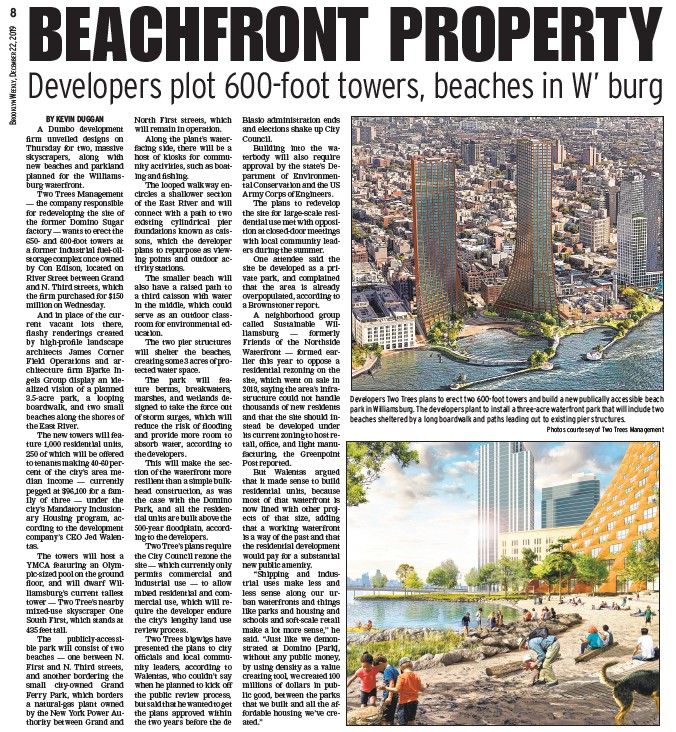
8
BROOKLYN WEEKLY, DECEMBER 22, 2019
BEACHFRONT PROPERTY
Developers plot 600-foot towers, beaches in W’ burg
BY KEVIN DUGGAN
A Dumbo development
fi rm unveiled designs on
Thursday for two, massive
skyscrapers, along with
new beaches and parkland
planned for the Williamsburg
waterfront.
Two Trees Management
— the company responsible
for redeveloping the site of
the former Domino Sugar
factory — wants to erect the
650- and 600-foot towers at
a former industrial fuel-oilstorage
complex once owned
by Con Edison, located on
River Street between Grand
and N. Third streets, which
the fi rm purchased for $150
million on Wednesday.
And in place of the current
vacant lots there,
fl ashy renderings created
by high-profi le landscape
architects James Corner
Field Operations and architecture
fi rm Bjarke Ingels
Group display an idealized
vision of a planned
3.5-acre park, a looping
boardwalk, and two small
beaches along the shores of
the East River.
The new towers will feature
1,000 residential units,
250 of which will be offered
to tenants making 40-60 percent
of the city’s area median
income — currently
pegged at $96,100 for a family
of three — under the
city’s Mandatory Inclusionary
Housing program, according
to the development
company’s CEO Jed Walentas.
The towers will host a
YMCA featuring an Olympic
sized pool on the ground
fl oor, and will dwarf Williamsburg’s
current tallest
tower — Two Tree’s nearby
mixed-use skyscraper One
South First, which stands at
435 feet tall.
The publicly-accessible
park will consist of two
beaches — one between N.
First and N. Third streets,
and another bordering the
small city-owned Grand
Ferry Park, which borders
a natural-gas plant owned
by the New York Power Authority
between Grand and
North First streets, which
will remain in operation.
Along the plant’s waterfacing
side, there will be a
host of kiosks for community
activities, such as boating
and fi shing.
The looped walkway encircles
a shallower section
of the East River and will
connect with a path to two
existing cylindrical pier
foundations known as caissons,
which the developer
plans to repurpose as viewing
points and outdoor activity
stations.
The smaller beach will
also have a raised path to
a third caisson with water
in the middle, which could
serve as an outdoor classroom
for environmental education.
The two pier structures
will shelter the beaches,
creating some 3 acres of protected
water space.
The park will feature
berms, breakwaters,
marshes, and wetlands designed
to take the force out
of storm surges, which will
reduce the risk of fl ooding
and provide more room to
absorb water, according to
the developers.
This will make the section
of the waterfront more
resilient than a simple bulkhead
construction, as was
the case with the Domino
Park, and all the residential
units are built above the
500-year fl oodplain, according
to the developers.
Two Tree’s plans require
the City Council rezone the
site — which currently only
permits commercial and
industrial use — to allow
mixed residential and commercial
use, which will require
the developer endure
the city’s lengthy land use
review process.
Two Trees bigwigs have
presented the plans to city
offi cials and local community
leaders, according to
Walentas, who couldn’t say
when he planned to kick off
the public review process,
but said that he wanted to get
the plans approved within
the two years before the de
Blasio administration ends
and elections shake up City
Council.
Building into the waterbody
will also require
approval by the state’s Department
of Environmental
Conservation and the US
Army Corps of Engineers.
The plans to redevelop
the site for large-scale residential
use met with opposition
at closed-door meetings
with local community leaders
during the summer.
One attendee said the
site be developed as a private
park, and complained
that the area is already
overpopulated, according to
a Brownstoner report.
A neighborhood group
called Sustainable Williamsburg
— formerly
Friends of the Northside
Waterfront — formed earlier
this year to oppose a
residential rezoning on the
site, which went on sale in
2018, saying the area’s infrastructure
could not handle
thousands of new residents
and that the site should instead
be developed under
its current zoning to host retail,
offi ce, and light manufacturing,
the Greenpoint
Post reported.
But Walentas argued
that it made sense to build
residential units, because
most of that waterfront is
now lined with other projects
of that size, adding
that a working waterfront
is a way of the past and that
the residential development
would pay for a substantial
new public amenity.
“Shipping and industrial
uses make less and
less sense along our urban
waterfronts and things
like parks and housing and
schools and soft-scale retail
make a lot more sense,” he
said. “Just like we demonstrated
at Domino Park,
without any public money,
by using density as a value
creating tool, we created 100
millions of dollars in public
good, between the parks
that we built and all the affordable
housing we’ve created.”
Developers Two Trees plans to erect two 600-foot towers and build a new publically accessible beach
park in Williamsburg. The developers plant to install a three-acre waterfront park that will include two
beaches sheltered by a long boardwalk and paths leading out to existing pier structures.
Photos courtesey of Two Trees Management